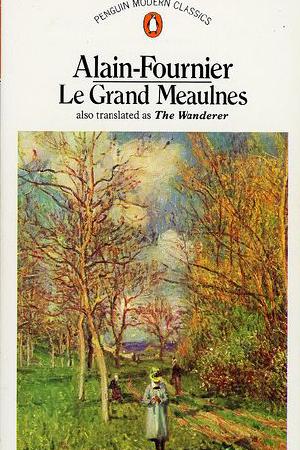Le Grand Meaulnes by Alain-Fournier

Henri-Alban Fournier was one of those noble souls lost in the opening stages of the Great War. His early death at 27 on the Western Front battlefield was enough for him to left behind one single novel: Le Grand Meaulnes. This is a novel with autobiographical overtones where the teenager longed love Yvonne de Quièvrecourt, serves as the spark to chain the events that shapes the novel’s core. François Seurel, a student in a small village of the rural France, recalls the arrival of the curious and charismatic student Agustin Meaulnes—Le Grand Meaulnes, reference from the French tall, big—. Together, the monotonous days in the village suddenly gain the wonder and vitality of youthful adventure.
In one of those adventures, eager to prove his brave, Meaulnes borrows a carriage to fetch Seurel’s grandparents, but in a turn of events, he got lost and ended up in an old ruined chateau. The inhabitants are preparing with splendor for the arrival of a mysterious groom and his bride to celebrate the wedding. While wandering, Meaulnes meets briefly the groom’s sister and daughter of the chateau’s owner, Yvonne De Galais, feeling instantly fascinated by her. After departing the chateau on a confusing night, Meaulnes becomes obsessed with returning to that enigmatic place, and see once more the object of his love.
For months, the attempts of Meaulnes and Seurel for reconstructing the map that might lead them back to the chateau are fruitless. After hearing a rumor that Yvonne might be in Paris, Meaulnes abruptly leaves the village in search for her. However, all is in vain and Meaulnes starts to consider he will never see her again, and in despair, asking Seurel to forget about everything. Years later, Seurel finds Yvonne, and determined to fulfill his vows, reunites Meaulnes with Yvonne, and after a few months of engagement, they marry. Meaulnes’s departure the day after his wedding, following the reappearance of a mysterious figure from the past, sets in motion the events that bring the the novel to its final climax.
The style of Alain-Fournier in Le Grand Meaulnes is evocative, immersing the reader in a state of nostalgia and longing of half-forgotten dreams. His description of the French countryside and child’s play conveys dreams of youth, creating a sensation of melancholy and invites the reader to think of that magical state lost that seems to be buried in the past. In this atmosphere, I cannot avoid thinking of a certain similarity in the feeling conveyed by Arthur Machen in The Hill of Dreams. Meaulnes’ quest can be seen as an unrequited love and the pursuit of an unattainable ideal built around the elusive figure hidden in a lost chateau, Yvonne De Galais.
Meaulnes’s complex character is reminiscent of the classic romantic hero driven by the desire for exploration. With the stubborn obsession of youth, but also coming to know the bitter taste of lost enthusiasm in adulthood, Meaulnes reluctantly abandons that door where everything seems possible, to enter the less vigorous, but resigned adulthood, and I believe that this point can be clearly marked when he asks Seurel to forget everything.
I thought too that our youth was over and we had failed to find happiness
Seurel, by contrast, pursuits the desire not for love, but for adventure, without becoming isolated by his obsessions and making friendship and loyalty his hallmarks. Unlike Meaulnes, he is less reckless, introspective and cautious. His eyes serve to comment on the events unfolding around him, and his reflections on youth are often used by Alain-Fournier to express the fleeting nature of youth.
Yvonne De Galais is an idealized love, perhaps symbolizing that joyful state Alain-Fournier himself was infatuated with, as well as the bittersweet nature of the dreams. Mysterious and beautiful, Meaulnes' search for her is the central theme of the work, and forces us to establish a balance between aspirations and reality—and to reflect about the complexity of idealized loves.
Alain-Fournier’s body was found in 1991 inside a German mass grave, and he now rests in a military cemetery. Eight years after his encounter with the real Yvonne, he knew again about her. Unlike his idealized version, she was by then married, and probably with children. However, she served as inspiration for a novel rich in imagery, and that captures at times the essence of the elusive love, and reminds us of the beauty of those days that will never return.